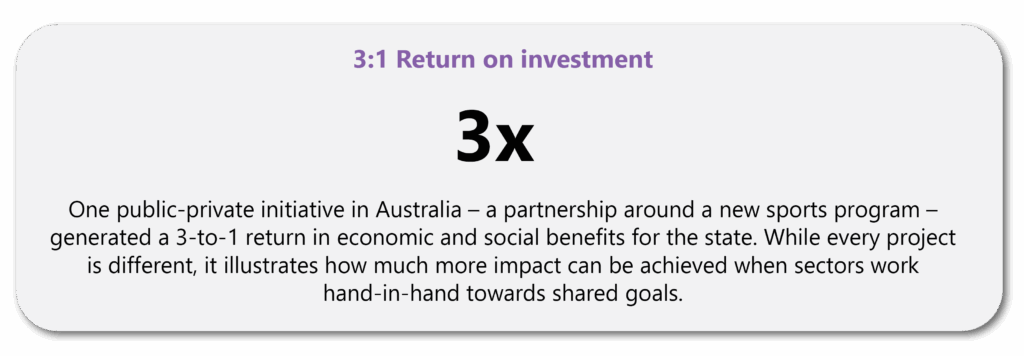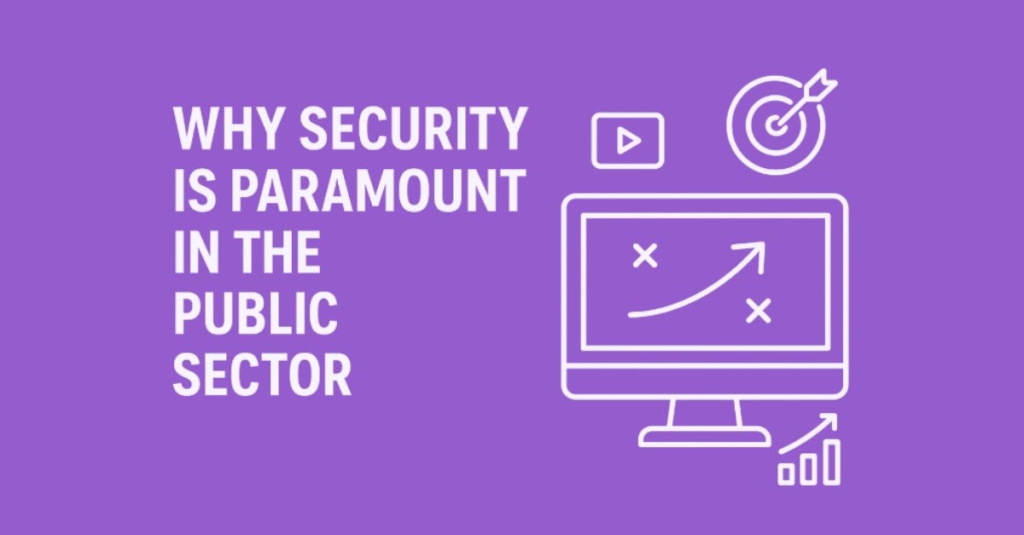Why is partnership valuable between public and private sectors?
Public and private sector collaboration can be a powerful engine for driving innovation and public value. In fact, leaders are recognising that reducing barriers between sectors – like excessive bureaucracy – is key to unlocking economic growth. As Jim Chalmers, Australia’s Treasurer, noted in a recent call to streamline regulations, “Cutting red tape means faster home builds, quicker loan approvals, and lower prices at the checkout…ensures growth isn’t choked by unnecessary or outdated processes.”
By cutting through red tape and forging genuine partnerships both governments and businesses can rapidly deliver outcomes that neither could achieve alone.

Six Key Elements of a Successful Public-Private Partnership
1. A Shared Mission and Values: The most successful partnerships start with alignment on purpose. Both public and private partners must see how their goals intersect. For government, that mission is public interest and service outcomes; for a company, it’s often profit, innovation and efficiency. Bridging these isn’t automatic – it takes conscious effort to frame projects in terms of public benefit.
By speaking a common language of purpose, partners can stay focused on creating societal value, not just completing a contract.
2. Trust, Transparency, and Integrity: Trust is the currency of partnership. The public sector in particular, values integrity above all – their own reputation is on the line when they bring in a private partner.
This means each side must be honest and open from day one. Private partners should be transparent about capabilities, pricing, and limitations; any hint of over-promising or hidden costs can erode trust immediately. It’s better to say “We cannot do X by that date, but we can offer Y alternative,” than to falter later. Governments, for their part, should be clear about their requirements, constraints (like legal or privacy mandates), and concerns.
3. Leadership Commitment: Strong partnerships often trace back to strong leadership. When top leaders champion the collaboration, it sends a message to everyone else that “this is important.” Leadership sets the tone for a partnership culture: encouraging problem-solving over finger-pointing, flexibility over bureaucracy, and long-term thinking over short-term gains. High-level support also helps knock down barriers. For instance, agency leaders can help “cut through” internal red tape or fast-track decisions that enable the private partner to be effective. Likewise, business leaders can authorise extra resources or custom solutions when public needs demand it.
Without engaged leadership on both sides, even well-intentioned partnerships can stall. With it, partners can navigate challenges together with confidence.
4. Open Communication and Collaboration: Real partnership requires day-to-day collaboration, not just executive buy-in. This means joint teams, regular check-ins, and a culture of sharing information. Instead of a traditional arms-length client-vendor split, a true partnership might embed private sector experts alongside public servants. Everyone works from the same project plans, risk registers, and success metrics. Challenges are tackled in the open, not hidden. Such transparency builds empathy – the agency understands constraints the company faces and vice versa. It also means welcoming healthy debate.
A partner who challenges the status quo constructively (asking “Why do it this way? Can we try a better way?”) can help the public sector innovate while still meeting requirements. Both sides should feel free to raise ideas or concerns – whether it’s the company suggesting a process improvement or the agency flagging a compliance issue – without fear of jeopardising the relationship. Open collaboration like this is only possible when trust is in place; together they create a powerful feedback loop driving continuous improvement.
5. Mutual Investment and Shared Risk: In a superficial partnership, each side might try to minimise their effort and risk – “we’ll do our part, you deal with the rest.” But meaningful partnerships demand skin in the game from both parties. Each must be willing to invest beyond the bare minimum, and openness to share risks in pursuit of bigger rewards. For the private partner, investment may mean upfront time spent truly understanding the agency’s needs. For the public sector, investment may come as senior staff time spend time on co-design workshops, flexibility in procurement or contract processes to enable innovation, or budget for pilot programs to test new approaches. Critically, both sides should be prepared to share risks as well, instead of the government pushing all risks onto the vendor (a common transactional approach).
6. Accountability and Results Orientation: Partnerships ultimately must deliver results. Clear accountability mechanisms keep a partnership on track. Jointly defined KPIs tied to public-service outcomes, regular performance updates of both partners, and transparency to stakeholders (e.g. public progress updates). True partners don’t hide from scrutiny; they embrace data and feedback. Private partners should measure not just their contract deliverables, but the end impact on citizens or end-users. Public partners should actively monitor and facilitate the work, not take a hands-off “throw it over the wall” approach. Importantly, when results fall short, true partners solve it together rather than defaulting to blame. For example, if a project milestone is missed, the response isn’t simply invoking contract penalties; instead, both sides convene to ask “How do we get this back on track? What do we need to adjust?” This joint problem-solving mentality ensures that the focus remains on outcomes, not outputs. And when targets are met or exceeded, both sides celebrate the win – typically leading to more trust and opportunities for future collaboration.
From Transactional to True Partnership: The Difference
It’s worth highlighting how a transactional approach differs from a true partnership approach, because this gets to the heart of why leadership and investment matter. In a transactional public-private relationship, the government procures a service, the company delivers it, and the relationship largely ends there. Success is defined narrowly (was the project delivered on time and on budget?), and the partnership dissolves once the transaction is done. There’s no deeper alignment or continuing commitment.
By contrast, a true partnership is an ongoing alliance. It’s not limited to one project – it’s about a longer journey of improvement. The private partner isn’t just a contractor; they are a trusted advisor and collaborator. And the public partner isn’t just an overseer; they actively engage and enable success. This kind of partnership tends to be iterative and evolving.
Crucially, real partnerships create additional value that transactions can’t. Because the private side is deeply invested, they are more likely to proactively bring forward innovations, best practices, and improvements (even those not asked for) to help the agency succeed. And the public side, seeing the private partner as an extension of their team, can integrate solutions more fully to achieve policy outcomes. The result: services that are more effective, citizens that are better served, and solutions that stand the test of time. This is why many government organisations now explicitly seek a “partner” rather than a vendor – they know the payoff is greater when incentives are aligned long-term. Even complex areas like environmental approvals saw major improvements when state agencies and industry worked in partnership to streamline processes.
In short, a true partnership multiplies impact – the whole becomes greater than the sum of its parts.

Conclusion: Partnership as the New Norm
In today’s complex environment, partnership is not just a buzzword – it’s a necessity. The challenges we face (from economic recovery to digital transformation in public services) are too big for any one sector to solve alone. When public and private sectors form true partnerships, they create a synergy that drives better outcomes for citizens, businesses, and society at large. Governments gain access to innovation, agility, and expertise from industry. Companies gain insight, scale, and purpose by working on initiatives that matter deeply to the public. But to unlock these benefits, partnerships must be approached deliberately – with strong leadership and a commitment to shared success that transcends any single contract.
It means keeping the ultimate goal in sight: delivering value to the public.
In summary, partnership between the public and private sectors is valuable because it combines strengths in ways that produce results neither side could achieve alone. But it only fulfills that promise when both sides treat each other as true partners – requiring honesty, openness, leadership engagement, and yes, sometimes the courage to challenge each other. The most effective partnerships aren’t always the easiest; they involve candid conversations and hard work. Yet, those very qualities – integrity, collaboration, co-creation – are what make the outcomes so much more impactful than a traditional vendor arrangement.
As we move forward, the line between public and private efforts will continue to blur, especially in areas like infrastructure, technology, healthcare, and education. Organisations that embrace genuine partnership will lead the way in showing how we can constructively work across sectors to solve big problems. Those that cling to transactional mindsets may deliver projects, but miss out on the deeper value creation and resilience that true collaboration offers.
To echo the forward-thinking sentiment in Australia’s current discourse: let’s cut the red tape and boost the economy – not just by deregulation, but by forging partnerships built on trust and shared vision. When we do that, we unleash not only economic benefits but also innovation, learning, and relationships that pave the way for future successes. And in that journey, everyone – government, business, and citizens – wins.
Get in touch today to learn more about Sensei’s Public Sector solutions.




